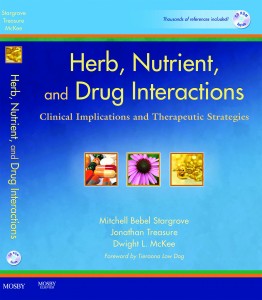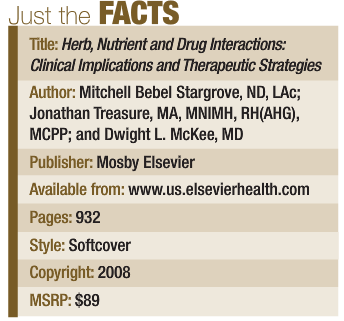Stacie Deyglio, ND
 This paramount reference text is designed to help clinicians safely and effectively integrate herbal, nutrient and synthetic (pharmaceutical) drug therapies. In today’s climate of transformation of the medical paradigm, clinicians are nationally sensing the pressure corresponding to the individual demands of 1) the emergence of personalized medicine; and 2) the self-education, self-prescribing patient. A margin of patients “naively assume that nutrient and herbal products are ‘natural’ and that this somehow implies they are ‘safe.’ More disturbing is the acknowledged fact that many patients often withhold disclosure of nutrients and herbal intake … from their conventional health care providers” (p. xiii). How may these patients be addressed in the clinical care setting? Beyond this truth lies a deeper malady in that “ignorance of other health care systems” (p. xx) exists and, commonly, individual medical disciples are both uninformed and unaware of the effects of each other’s therapies.
This paramount reference text is designed to help clinicians safely and effectively integrate herbal, nutrient and synthetic (pharmaceutical) drug therapies. In today’s climate of transformation of the medical paradigm, clinicians are nationally sensing the pressure corresponding to the individual demands of 1) the emergence of personalized medicine; and 2) the self-education, self-prescribing patient. A margin of patients “naively assume that nutrient and herbal products are ‘natural’ and that this somehow implies they are ‘safe.’ More disturbing is the acknowledged fact that many patients often withhold disclosure of nutrients and herbal intake … from their conventional health care providers” (p. xiii). How may these patients be addressed in the clinical care setting? Beyond this truth lies a deeper malady in that “ignorance of other health care systems” (p. xx) exists and, commonly, individual medical disciples are both uninformed and unaware of the effects of each other’s therapies.
The Herb, Nutrient and Drug Interactions reference text was designed to provide a well-investigated approach to the reality of herb, nutrient and drug interactions. Combining pharmaceuticals with herbs or supplements may yield consequences that can complement (or interfere) with a drug’s therapeutic action and/or may increase adverse effects. Additionally, drug-induced depletion of nutrients may occur and must be supplemented for to resolve deficiencies. The book contains more than 60 comprehensive monographs of herb-drug and nutrient-drug interactions, divulging the most commonly used herbs and nutrients in clinical practice. The monographs feature summary tables and concise suggestions complementing the in-depth analysis as well as providing a quick and easy reference. The text of the book refers to evidence from clinical trials primarily; secondarily it relies on human research. Lastly, it refers to animal studies or in vitro experiments to a supportive position. The references are included on a CD, bound with the book. This up-to-date information provides current, evidence-based support of the latest developments in pharmacology, nutrition, phytotherapy, naturopathic medicine and other fields.
 In defining a comprehensible understanding of how herbal remedies and nutritional supplements interact with pharmaceuticals, Herbs, Nutrient and Drug Interactions best supports the naturopathic principle of Primum Non Nocere. By providing evidence-based methods that minimize the risk of harmful side effects, clinicians using this text may cultivate confidence in the development of safe, individualized treatment strategies for patients.
In defining a comprehensible understanding of how herbal remedies and nutritional supplements interact with pharmaceuticals, Herbs, Nutrient and Drug Interactions best supports the naturopathic principle of Primum Non Nocere. By providing evidence-based methods that minimize the risk of harmful side effects, clinicians using this text may cultivate confidence in the development of safe, individualized treatment strategies for patients.
Note: Readers are invited to send additions, corrections, citations and other input and feedback to Interactions2@MedicineWorks.com, and to join a forum for sharing news, research and case discussions on interactions issues at http://forums.medicineworks.com/.
 Stacie Deyglio, ND received her baccalaureate degree in biology with a minor in chemistry from the College of Mt. St. Vincent in New York. Personal health issues paved her way to discover naturopathic medicine in 1999. Resonating with the philosophy and principles of naturopathic medicine, Deyglio graduated from the University of Bridgeport College of Naturopathic Medicine in 2003. As a medical student, she was actively involved in student government, fundraising and the generation of two successful student-run health fairs. Currently residing in Arizona, Deyglio is an avid bookworm who is actively creating her practice after a three-year sabbatical taken to raise her son.
Stacie Deyglio, ND received her baccalaureate degree in biology with a minor in chemistry from the College of Mt. St. Vincent in New York. Personal health issues paved her way to discover naturopathic medicine in 1999. Resonating with the philosophy and principles of naturopathic medicine, Deyglio graduated from the University of Bridgeport College of Naturopathic Medicine in 2003. As a medical student, she was actively involved in student government, fundraising and the generation of two successful student-run health fairs. Currently residing in Arizona, Deyglio is an avid bookworm who is actively creating her practice after a three-year sabbatical taken to raise her son.

